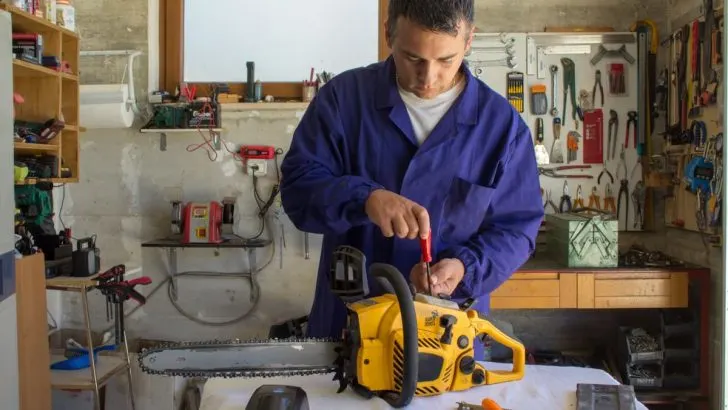If your chainsaw stops or bogs down when you give it gas, you can fix it by cleaning the clogged-up fuel or air filter. Also, clean your spark arrestor. This problem can also occur if your carburetor is clogged or the carburetor is not mixing fuel and air in the correct ratio.
There are several possible causes for your chainsaw’s trigger stopping when it’s pulled. You can address most of them by following the steps below.
1. Clean the Spark Arrestor
The first thing you should do when your chainsaw isn’t working is to check the spark arrestor. Located at the rear of your chainsaw, the spark arrestor (as its name suggests) prevents sparks from coming out of the muffler and potentially burning you (or worse).
Once you find the housing for the spark arrestor, you’d have to twist a few screws off a metal net to get to the arrestor. After separating it from the housing, inspect the spark arrestor and check whether it’s clogged. Use a wire brush or propane torch to clean it out. Cleaning this component should resolve the issue.
Make sure you put everything back together and screw on the parts you separated from the chainsaw. If this doesn’t fix the problem, proceed to the next step below.
In the meantime, you can watch this video that talks about a stalled chainsaw:
2. Empty the Gas Tank and Inspect the Fuel Filter
A bad or clogged-up fuel filter is a common issue in chainsaws. When you don’t use your chainsaw for an extended period, the gas in the tank can turn bad and ruin your fuel filter.
The fuel filter’s job is to feed clean fuel to the carburetor. When the gas in the tank goes “bad,” the filter cleaning the gas will get stuck with debris and other deposits. Luckily, there are ways to prevent this, such as using a fuel stabilizer.
To fix this issue, do the following:
- Empty the fuel tank. Since the fuel filter rests at the bottom of the tank, you’d have to empty the tank to get to it. Do this by using a turkey baster.
- Grab a dental pick and reach the fuel filter. Once you’ve emptied the tank, use a dental pick or a similar instrument to fish out the fuel line and get to the filter. You can use a flashlight to spot the fuel filter inside the tank.
- Inspect the fuel filter for signs of blockage. Check the filter and see if you can find any signs of clogging. In most cases, it will be easier to replace the filter altogether.
- Attach the new filter to the fuel line. Once you have a new fuel filter, attach it to the fuel line where the old filter used to be.
- Fill the tank with fresh gas and do a test run. Ensure that you use new gas to test out the chainsaw after replacing the fuel filter. You can also use a fuel stabilizer or pre-mixed fuel designed for two-stroke engines.
If you’re looking for a fuel filter that works with most chainsaws, I recommend the E-outstanding Fuel Filter (link to Amazon).
3. Clean or Replace the Air Filter
Sometimes, both your fuel and air filters could be clogged. So, after you replace the fuel filter, check to see if the air filter is in good shape.
The air filter’s job is to provide air for combustion inside the chamber. If your chainsaw isn’t getting enough air due to a dirty air filter, it will bog down when you rev it (source).
Figure out the location of the air filter on your chainsaw. It’s usually on the back of the chainsaw, but the actual location may vary slightly depending on the model. If you have a manual for your chainsaw, you may want to consult it for the location of the air filter.
Once you get the air filter out of the chainsaw (you may have to use a screwdriver for this), thoroughly inspect it.
If it’s dirty or clogged, clean it up with high-pressure air or soak it in soapy water.
If you see signs of damage or wear on the filter, I recommend that you replace it with a new one.
4. Inspect the Carburetor
As I’ve said earlier, if you leave gas in your tank for extended periods, it can go bad. When a chainsaw runs on bad fuel, your carburetor can get clogged by the deposits in that fuel.
Therefore, it’s important to check the carburetor since it’s responsible for adjusting the ratio of the gas and air mixed together to feed the engine.
For this part, you’d have to disassemble the carburetor and clean it up with a cleaner specifically designed for it. If this task is too technical for you, you can always call a professional.
Alternatively, you can just replace the carburetor with a new one. You can usually find them at a reasonable price, and many of them come with kits. Some of these kits even come with a new fuel filter, so that’s two birds with one stone.
Ensure that you reattach all the connections to the carburetor before running it again. You might have to play around with the adjustment screws on your new carburetor to fine-tune it.
Refer to the video below for guidance.
Conclusion
There are many reasons your chainsaw may stop when the trigger is pulled. As you can see, most of them can be avoided by regularly maintaining your chainsaw.
Always empty your fuel tank before storing your chainsaw for extended periods. This should prevent problems like a clogged fuel filter or carburetor. If you have issues like these, you can either clean or replace the affected parts.

